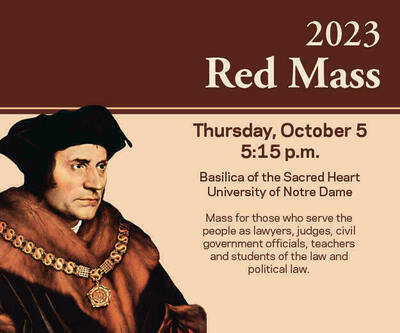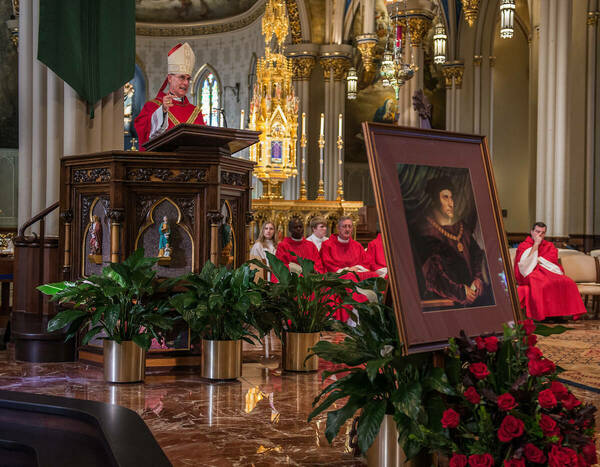The History and Tradition of the Red Mass

The annual Red Mass will be held today, October 5, at 5:15 p.m. in the Basilica of the Sacred Heart at the University of Notre Dame.
The Red Mass is a special devotion to the Holy Spirit and a prayer for the virtues of wisdom, understanding, counsel, patience, energy, and courage. Lawyers, judges, government officials, scholars, and others working in the legal field attend the Red Mass to pray for divine guidance over their work for the pursuit of legal justice. People of all faiths are invited to join in celebrating the Red Mass.
“The traditional Red Mass is a wonderful, welcome opportunity for lawyers around the country to pray, in solidarity, for God's blessings on our profession and his guidance in our vocation,” said Richard Garnett, the Paul J. Schierl/Fort Howard Corporation Professor of Law and director of the Program on Church, State & Society. “It is particularly appropriate, given the Notre Dame Law School's commitment to student formation, and to the cooperation of faith and reason, that the Red Mass is celebrated on campus.”
The first Red Mass celebrated at Notre Dame on May 29, 1955 in Sacred Heart Church (now the Basilica of the Sacred Heart). The idea of having a Red Mass was proposed by Joseph O'Meara, the dean of the Law School at that time.
That inaugural Mass was organized through the efforts of the Student Law Association and was attended by both students and faculty of the Law School, along with members of the St. Joseph County Bar. Reverend Theodore M. Hesburgh, C.S.C., gave the sermon, which focused on the example of St. Thomas More, the patron saint of lawyers, politicians, and civil servants.
Today, the tradition of attending the Red Mass continues to be embraced by faculty and students.
Third-year law student Bernadette Shaughnessy said, “Our faith must be part and parcel of what we do. A Catholic attorney lives out her faith by serving her clients. A Catholic judge lives out her fidelity to Christ through fidelity to the law.”
She added, “The law is not an easy vocation. It is difficult mentally, spiritually, and physically. The Red Mass forces us to pause. It forces us to remember why we are attorneys and Who we ultimately serve through our service to others.”
The original Red Mass was held in Paris in 1245 at the Sainte Chapelle. Built by King Louis IX (St. Louis), the Sainte Chapelle was exclusively used by the Order of the Advocates, namely its Advocates and Judges. After the chapel’s restoration following the French Revolution, it was dedicated for the “Messe Rouge,” or Red Mass.
The tradition of an annual Red Mass took hold in England in 1310 at Westminster Abbey. It marked the beginning of the Michaelmas term, or the start of the academic year. During the Mass, the priest and all Lord High justices in attendance wore scarlet robes, a practice also adopted by legal scholars on their academic gowns. Today, the celebrants still wear scarlet robes, both stemming from this tradition of the 14th century and to symbolize the tongues of fire of the Holy Spirit. Large Red Mass celebrations annually occur in some of Europe’s most prominent cathedrals.

In the United States, the first Red Mass was held in October, 1928 in New York City in the old St. Andrew’s Church. Washington, D.C. now holds one of the largest Red Mass celebrations at the beginning of each Supreme Court term. In 1940, Fr. John O’Hara, the former president of the University of Notre Dame, delivered the Red Mass sermon at the National Shrine of the Immaculate Conception in Washington, D.C. The Red Mass is now held annually in a handful of large cities all across the United States, including at the Basilica of the Sacred Heart.